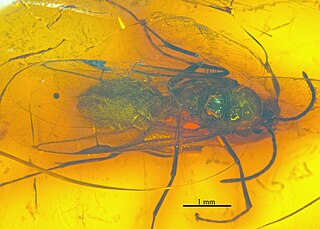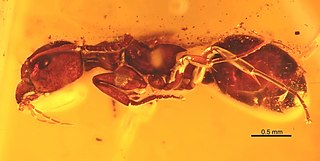Dolichoderus affectus is an extinct species of ant in the genus Dolichoderus. Described by Théobald in 1937, the fossils were discovered in France.
Dolichoderus angusticornis is a species of ant in the genus Dolichoderus. Described by John S. Clark in 1930, the species is endemic to Australia, found in dry scrub heath in Western Australia and South Australia. Workers are diurnal and foraging during the day and at night.

Dolichoderus balticus is an extinct species of Eocene ant in the genus Dolichoderus. Described by Mayr in 1868, the fossils of a worker, queen and male of the species were discovered in the Baltic Amber.
Dolichoderus bruneti is an extinct species of ant in the genus Dolichoderus. Described by Théobald in 1937, the fossils were discovered in France.
Dolichoderus coquandi is an extinct species of ant in the genus Dolichoderus. Described by Théobald in 1937, the fossils were discovered in France.

Dolichoderus cornutus is an extinct species of Eocene ant in the genus Dolichoderus. Described by Mayr in 1868, the fossils were discovered in the Baltic amber, where a fossilised worker ant was only described, and it is presumed these ants existed at least 40 million years ago.
Dolichoderus dibolius is an extinct species of Miocene ant in the genus Dolichoderus. The fossils were found in the Dominican Amber, and was described by Wilson in 1985.
Dolichoderus evolans is an extinct species of Miocene ant in the genus Dolichoderus. Described by Zhang in 1989, the fossilised species was discovered in China, where a possible queen has been described.
Dolichoderus feae is a species of ant in the genus Dolichoderus. Described by Emery in 1889, it is endemic to multiple countries, notably China, India, Myanmar (Burma) and Thailand.
Dolichoderus ghilianii is a species of ant in the genus Dolichoderus. Described by Emery in 1894, the species is endemic to Brazil, and Peru.
Dolichoderus imitator is a species of ant in the genus Dolichoderus. Described by Emery in 1894, the species is endemic to Bolivia, Brazil and Ecuador.

Dolichoderus longipennis is an extinct species of Eocene ant in the genus Dolichoderus. Described by Mayr in 1868, the fossils were discovered in the Baltic Amber.
Dolichoderus oviformis is an extinct species of Oligocene ant in the genus Dolichoderus. Described by Théobald in 1937, fossilised males and queens were found in France and have been described.

Dolichoderus rohweri is an extinct species of ant in the genus Dolichoderus. Described by Carpenter in 1930, the fossils of this species are only found in the Florissant Formation, Colorado.

Dolichoderus sculpturatus is an extinct species of ant in the genus Dolichoderus. Described by Mayr in 1868, a fossilised worker was discovered and described in the Baltic amber.
Dolichoderus tauricus is an extinct species of Miocene ant in the genus Dolichoderus. Described by Dlussky in 1981, the fossils were found in Russia.

Dolichoderus tertiarius is an extinct species of Eocene ant in the genus Dolichoderus. Described by Mayr in 1868, fossils of a worker, queen and male were discovered and described in the Baltic amber.
Dolichoderus transversipetiolaris is an extinct species of Miocene ant in the genus Dolichoderus. Described by Zhang, Sun and Zhang in 1994, the species was discovered after a fossil of a queen was found in China.
Dolichoderus tricolor is a species of ant in the genus Dolichoderus. Described by Emery in 1914, the species is endemic to New Caledonia.

Dolichoderus vectensis is an extinct species of Oligocene ant in the genus Dolichoderus. Described by Donisthorpe in 1920, the fossils of the species were found in the United Kingdom.







